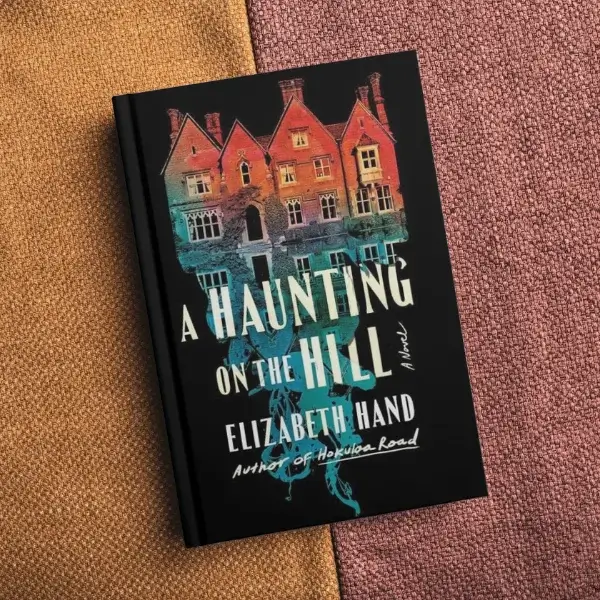If you’re planning a unique getaway, consider the eerie allure of Hill House, tucked away upstate in a remote stretch of woods. Picture a sprawling mansion steeped in mystery, its gothic charm hiding a sinister edge. Elizabeth Hand’s novel, A Haunting on the Hill, invites readers back into the unsettling world originally created by Shirley Jackson. With every page, the shadows of spirits and the whispers of vengeful teens come to life, turning the familiar into the chillingly unfamiliar.
What struck me most about the novel is how it captures the same sense of creeping dread that inspired Mike Flanagan’s acclaimed Netflix series. The haunting atmosphere is layered with unsettling details—peeling wallpaper, flickering light fixtures, and even the possibility of evil rabbits lurking just out of sight. Much like an unforgettable Airbnb stay gone terribly wrong, it leaves you wondering if packing holy water might have been a smart idea. Hand’s authorized continuation of Jackson’s classic tale feels both fresh and deeply respectful, offering a cozy yet deeply unsettling descent into horror.
Shadows of Terror
Elizabeth Hand’s contemporary take on horror in A Haunting on the Hill feels like stepping into an original, iconic setting brought to life with a genuinely chilling atmosphere. Her story unfolds as a slow burn, each chapter pulling the reader deeper into a world of subtle yet oppressive terror. I first read it primarily at night, and the shadows in my room seemed darker, shifting with eerie intent.
The narrative is an excellent addition to Shirley Jackson’s legacy, though Hand’s voice stands firmly on its own. As I found myself dealing with bouts of pregnancy-related insomnia, the book became a companion that both thrilled and unnerved me. Hand’s ability to create a sense of a hand closing tighter around your throat with each page is nothing short of masterful. The story isn’t gory, but it doesn’t need to be—its power lies in the freaky sense of unease that permeates every scene, amplified by the official plot, which the publisher aptly describes as haunting.
An Unforgettable Retreat
A struggling playwright, Holly Sherwin, finally sees a chance for her big break when a grant allows her to develop her play, The Witch of Edmonton. Desperate for time and space to bring her vision to life, she ventures on a weekend getaway to the upstate countryside and stumbles upon Hill House. The ornate, gothic mansion, though crumbling and almost hidden in a remote village, feels like the perfect place for Holly to rehearse her play. Its enormous, old, and deeply eerie presence captivates her imagination, offering the ideal backdrop for her creative process.

Though filled with hesitations, her girlfriend Nisa agrees to help by renting the house for a month. Soon, a troupe of actors arrives, each carrying their own ghosts. As they settle, peculiarities emerge—the house reveals its secrets with disturbing sounds, strange creatures that stalk the grounds, and a shift in time that unsettles everyone. The group’s dynamics strain, and Holly finds herself at odds with both her friends and the house itself. It becomes clear that something has been waiting in Hill House for years, and now it no longer intends to walk alone.
Twisted Bonds and Shattered Dreams
When Holly, Nisa, Stevie, and Amanda arrive at Hill House, their trip begins with the potential for artistic camaraderie but spirals into a nightmarish descent. As the candidates for the house’s malevolent influence, these four are the perfect victims: self-centered, emotionally vulnerable, and each uniquely broken. The house doesn’t need to try too hard to warp their perspectives—it plays on their weaknesses with dark precision.
The tension between the characters quickly builds. Sniping and bickering over Holly’s play become central to their unraveling, with disputes about who gets more lines, who’s stealing the spotlight, and who will bask in the glory of their debut. These conflicts, though rooted in their choice to visit this sinister vacation home, feel both inevitable and heightened by the sinister power of Hill House. It’s as though the house itself is a puppet master, weaving dark suggestions into their minds, pushing them further apart. The tension has a strange energy—chaotic but also strangely fun, as if watching sensitive actors in a doomed play they can’t escape.
Subtle Layers of Terror
When reading A Haunting on the Hill, I couldn’t help but think about how the book masterfully evokes genuine terror without relying on big, loud set pieces of horror. Instead, it skews toward a buildup of a million little unsettling things. These details add up to a deeply frightening atmosphere that lingers long after the pages are turned. The book skillfully builds dread through subtleties—the sense of time passing quickly, the layout of rooms changing seemingly without reason, or the eerie presence of an odd knife-wielding neighbor.
There’s a haunting visual quality, too, like the face of a large black hare stretching into an abnormally wide human grin. These chilling moments feel real and unshakable as the horror arrives fully-formed, impossible to ignore. Each carefully placed scene feels like a creeping shadow, intensifying dread with every turn. It’s a tale where the unseen and the unexplained hold the most power, creating a palpable unease that’s impossible to forget.
Immersive Atmosphere and Eerie Charm
Elizabeth Hand’s A Haunting on the Hill draws readers into a highly atmospheric world, where every odd detail of the house is both unsettling and excellent. The descriptions are rich and vivid, painting a picture of creeping unease that clings to you. The story’s slow pacing fits the nature of its creepy narrative, creating a rhythm that allows the dread to simmer, though it might bother those expecting jump scares right away. However, this deliberate approach doesn’t throw the tale off; instead, it amplifies the tension, making each chilling moment even more impactful.
Hand’s choice to write from multiple POVs is a masterstroke, offering a deeper understanding of the four characters as they confront the monotony and madness within the house. Their brain-breaking descent into the nightmare feels personal, pulling readers into their fractured perspectives. It’s the type of eerie read that pulls you along, bit by chilling bit, until you’ve realized it’s too late to escape.
The story plays with the idea of isolation and how being stuck in one’s mind—or one place—can drive someone insane. And yet, beneath the fear, there’s a fun and morbid curiosity that lingers. After all, who can say they wouldn’t be drawn to such a creepy, unforgettable journey?
Here are more recommendation if you consider more horror books!


12 thoughts on “Horror Book Review: “A Haunting on the Hill” by Elizabeth Hand”